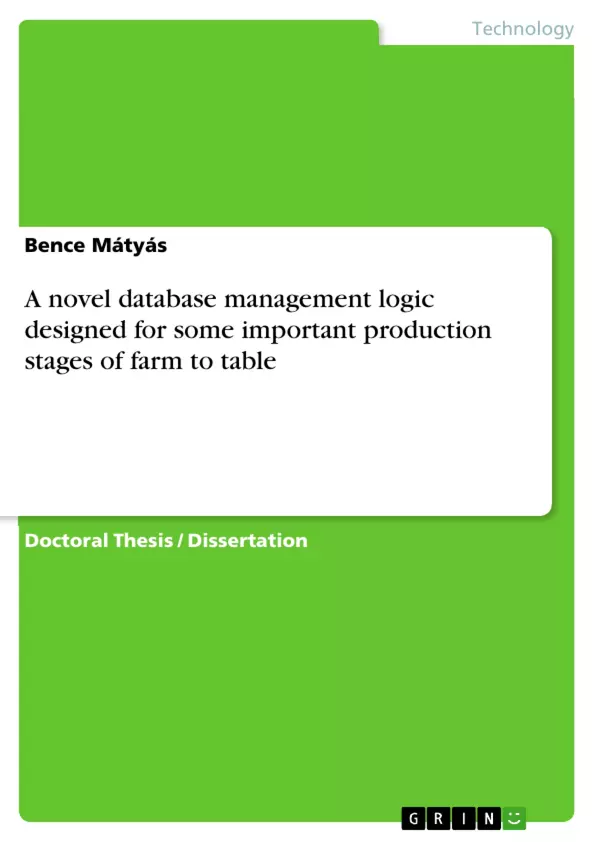The primary goal of the present dissertation is to introduce a self-developed data storage logic called Joker Tao (JT), which provides the opportunity to store and manage each input data in one (physical) data table while the data storage concept is structured. JT allows any data whether entity, attribute, data connection or formula, to be stored and managed under just one physical data table. In the JT logic based databases, the entity and the attribute are used interchangeably, so users can expand the database with new attributes either during or after the development process. With JT logic, data storage using one physical data table is ensured in SQL database system for the storage and management of long-term scientific information.
I examined the effects and importance of JT during some production stages of farm to table. Namely, the interoperability between soil and GHG production data from different data storage structures, data relating to food-stock records, billing and payroll in the baking industry are examined in this dissertation. With regard to development, the results show that in case of 1000 records or more (positive results) significantly faster queries could be realized with JT model usage in cloud compared to relational databases (in Oracle APEX environment). The results show that from 10000 records the relational model generates slow (more than 1 second) queries in a cloud-based environment while JT can remain within a one second time frame.
Farm-to-table refers to the stages of food production and is associated with sustainable agriculture. Studies on climate change and greenhouse gas emissions linked to soil cultivation require large amounts of data. These data are mainly inducted from laboratory measuring devices or from various systems including geographical information and other specific systems, which operate with data from different data storage structures. Operating with data from different data storage structures is a challenge for companies and research institutes. Modern database management systems fall into two broad classes: RDBMS and NoSQL. The interoperability between SQL and NoSQL often garners considerable attention in the world of databases, with many solutions to have been proposed to solve this issue. There are some initiations in the literature about converting systems. I focused on creating a data storage logic, which increases the performance of NoSQL data storage concept-based RDBMS database management system.
Inhaltsverzeichnis (Table of Contents)
- Introduction
- Comparison of different database models
- Rivarly between NoSQL and SQL
- Knowledge-based systems development
- Joker Tao
- Comparison of JT and ontological modeling
- Mathematical definitions of the relational database model and JT database model
- Mathematical definition of the relational database model
- Mathematical definition of the JT database model
- State of the art
- Relational systems
- NoSQL systems
- Objectives of my research and development
- Methods
- Research methods
- The developed data storage and management methods
- Four dimension of knowledge stored in data table
- The developed JT algorithm exerting method
- Virtual data table management
- Indexing in JT
- Converting data tables to one physical data table
- Storing and processing the unknown, or from the data to the information
- Technological environment
- Cloud-based solutions
- Results and discussion
- Research results
- Development results
- JT database management
- JT seed
- ID usage
- JT attribute
- T_sequence and value
- The dialectic of entity and attribute
- JT Shell
- Application Initialization (login) and access controls
- Efficiency indicators
- Development directions
- Subset determination in JT logic
- Conclusions
- Conclusions of the research results
- Conclusions of the development results
- New and novel results
Zielsetzung und Themenschwerpunkte (Objectives and Key Themes)
This dissertation presents a novel database management logic, named Joker Tao (JT), specifically designed for key production stages within the "farm to table" food production chain. The study aims to address the limitations of traditional database models, particularly in handling complex and dynamic data associated with agricultural production and distribution. The research focuses on developing a robust and efficient database system that can effectively capture, store, and manage the various forms of knowledge related to this domain.
- Comparison of different database models, including SQL and NoSQL
- Development and implementation of the JT database logic
- Application of JT in the management of agricultural data
- Analysis of the efficiency and scalability of the JT system
- Evaluation of the potential benefits and limitations of JT in the "farm to table" context
Zusammenfassung der Kapitel (Chapter Summaries)
- Chapter 1: Introduction This chapter sets the stage for the dissertation by discussing the challenges of managing agricultural data, comparing different database models, and introducing the concept of Joker Tao (JT). It outlines the research objectives and the need for a new approach to database management in the context of food production.
- Chapter 2: Methods This chapter details the research methods employed in the dissertation. It discusses the development of the JT algorithm and the underlying principles of the new database management logic. The chapter further explores the technological environment in which the JT system operates, including cloud-based solutions.
- Chapter 3: Results and Discussion This chapter presents the research findings and a detailed discussion of the JT database management system. It explores various aspects of the system, including JT seed, ID usage, JT attributes, and the JT shell.
Schlüsselwörter (Keywords)
This dissertation focuses on the following keywords: database management, Joker Tao (JT), agricultural data, knowledge-based systems, farm to table, NoSQL, SQL, relational database model, ontological modeling, cloud computing, data storage, data processing, information management, efficiency, scalability.
- Quote paper
- Bence Mátyás (Author), 2016, A novel database management logic designed for some important production stages of farm to table, Munich, GRIN Verlag, https://www.grin.com/document/415404



